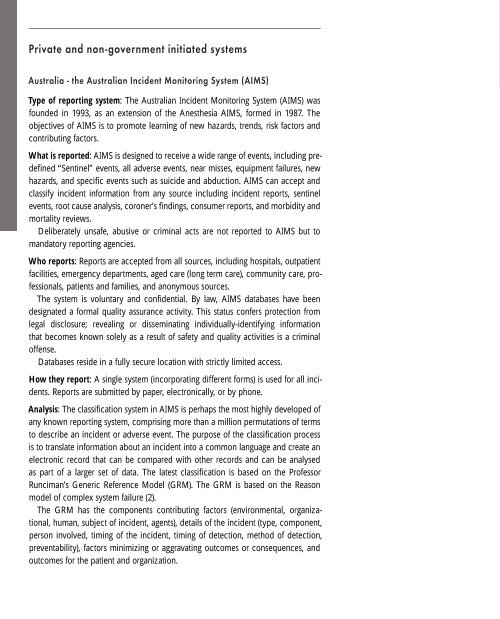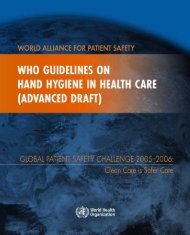Adverse event reporting.pdf
Adverse event reporting.pdf
Adverse event reporting.pdf
Create successful ePaper yourself
Turn your PDF publications into a flip-book with our unique Google optimized e-Paper software.
Private and non-government initiated systems<br />
Australia - the Australian Incident Monitoring System (AIMS)<br />
Type of <strong>reporting</strong> system: The Australian Incident Monitoring System (AIMS) was<br />
founded in 1993, as an extension of the Anesthesia AIMS, formed in 1987. The<br />
objectives of AIMS is to promote learning of new hazards, trends, risk factors and<br />
contributing factors.<br />
What is reported: AIMS is designed to receive a wide range of <strong>event</strong>s, including predefined<br />
“Sentinel” <strong>event</strong>s, all adverse <strong>event</strong>s, near misses, equipment failures, new<br />
hazards, and specific <strong>event</strong>s such as suicide and abduction. AIMS can accept and<br />
classify incident information from any source including incident reports, sentinel<br />
<strong>event</strong>s, root cause analysis, coroner’s findings, consumer reports, and morbidity and<br />
mortality reviews.<br />
Deliberately unsafe, abusive or criminal acts are not reported to AIMS but to<br />
mandatory <strong>reporting</strong> agencies.<br />
Who reports: Reports are accepted from all sources, including hospitals, outpatient<br />
facilities, emergency departments, aged care (long term care), community care, professionals,<br />
patients and families, and anonymous sources.<br />
The system is voluntary and confidential. By law, AIMS databases have been<br />
designated a formal quality assurance activity. This status confers protection from<br />
legal disclosure; revealing or disseminating individually-identifying information<br />
that becomes known solely as a result of safety and quality activities is a criminal<br />
offense.<br />
Databases reside in a fully secure location with strictly limited access.<br />
How they report: A single system (incorporating different forms) is used for all incidents.<br />
Reports are submitted by paper, electronically, or by phone.<br />
Analysis: The classification system in AIMS is perhaps the most highly developed of<br />
any known <strong>reporting</strong> system, comprising more than a million permutations of terms<br />
to describe an incident or adverse <strong>event</strong>. The purpose of the classification process<br />
is to translate information about an incident into a common language and create an<br />
electronic record that can be compared with other records and can be analysed<br />
as part of a larger set of data. The latest classification is based on the Professor<br />
Runciman’s Generic Reference Model (GRM). The GRM is based on the Reason<br />
model of complex system failure (2).<br />
The GRM has the components contributing factors (environmental, organizational,<br />
human, subject of incident, agents), details of the incident (type, component,<br />
person involved, timing of the incident, timing of detection, method of detection,<br />
pr<strong>event</strong>ability), factors minimizing or aggravating outcomes or consequences, and<br />
outcomes for the patient and organization.
















